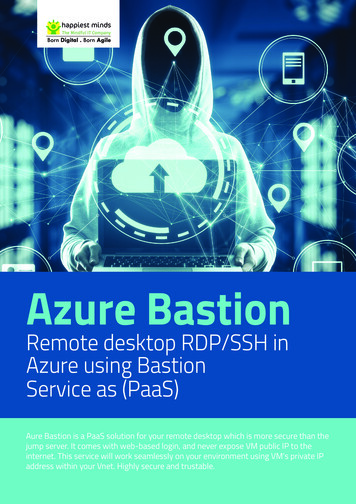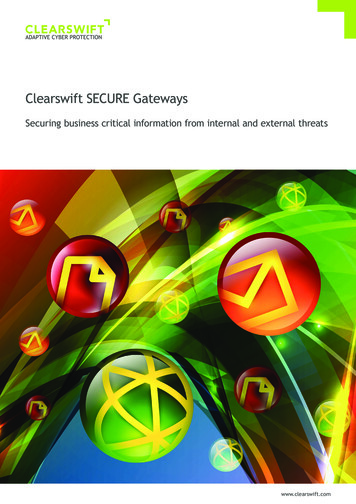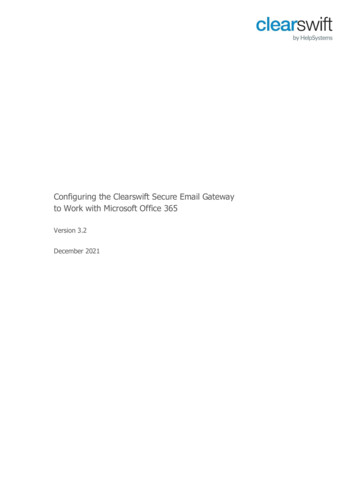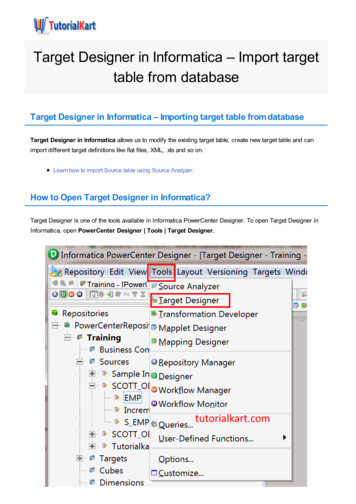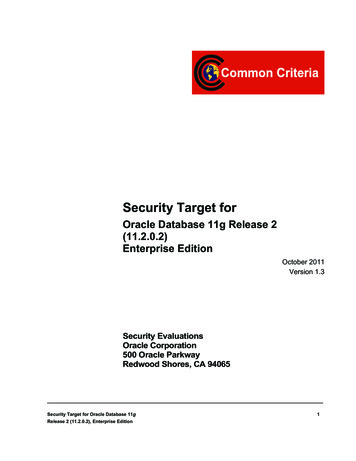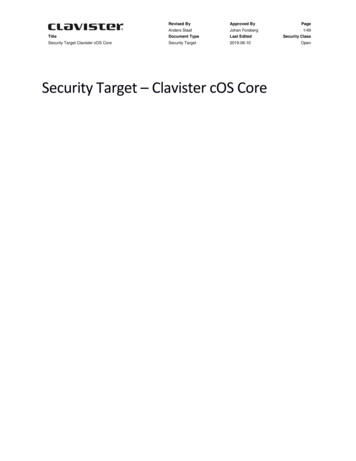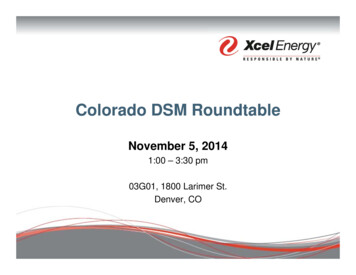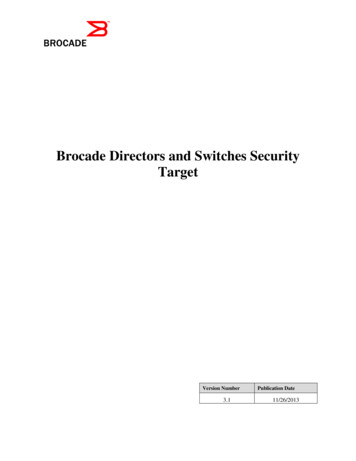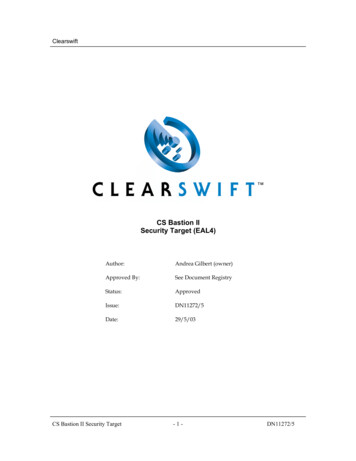
Transcription
ClearswiftCS Bastion IISecurity Target (EAL4)Author:Andrea Gilbert (owner)Approved By:See Document CS Bastion II Security Target-1-DN11272/5
ClearswiftTable of Contents1.INTRODUCTION . 31.11.21.31.41.51.62.TOE DESCRIPTION . 72.12.22.32.43TOE Security Requirements . 16Security Requirements for the IT environment. 18TOE SUMMARY SPECIFICATION. 196.16.27Security objectives for the TOE. 13Security Objectives for the environment . 13IT SECURITY REQUIREMENTS. 165.15.26Secure Usage Assumptions. 10Assumptions concerning the TOE Environment. 11Threats. 11SECURITY OBJECTIVES . 134.14.25Overview . 7Design Rationale . 7Summary of Security Features. 8Evaluated Configuration. 8TOE SECURITY ENVIRONMENT . 103.13.23.34ST Identification. 3ST Overview. 3CC Conformance . 3Re-Evaluation . 3Definitions . 4References . 6TOE Security Functions . 19Assurance Measures . 21RATIONALE. 247.17.27.3Security objectives rationale. 24Security Requirements rationale. 27TOE Summary specification rationale. 29CS Bastion II Security Target-2-DN11272/5
Clearswift1.Introduction1.1ST IdentificationTitle: CS Bastion II Security Target (EAL4).TOE Version: CS Bastion Version 2.0.0 (marketed as CS Bastion II; also referred to in this Security Targetas Clearswift Bastion 2 (CSB2)).Keywords: Firewall, proxy firewall, application-level firewall, bastion, X.400, SMTP, ROSE, DISP, FTP,Trusted Solaris, TSOL, Compartmented Mode Workstation (CMW), MAC.This document is the security target for the Common Criteria [CC] EAL4 evaluation of the ClearswiftBastion 2 product and is conformant with the CC.1.2ST OverviewThis Security Target (ST) specifies the environment, security objectives, security requirements and securityfunctions for the CC EAL4 evaluation of the Clearswift Bastion 2 product.Clearswift Bastion 2 (CSB2) is an application-level firewall designed for use between incompatible ormutually mistrusting networks. Its primary goal is to provide assured network separation, while permittinglimited authorized message transfer. That is, an assurance that network traffic cannot be accidentally ordeliberately leaked between (subscriber) networks via CSB2 outside of the pre-defined and tightlycontrolled message channels provided by the CSB2 software.CSB2 also offers a protected DMZ into which additional software modules can be installed to police thetraffic flow between networks. One DMZ module is the CSB2 archive utility, which will take a backupcopy of all data passing through the firewall to a protected section of disc.CSB2 currently supports X.400 and SMTP protocols by making use of commercial-of-the-shelf networkingproxies, adapted to suit the bastion architecture, it also offers a variety of optional software modules topolice and manage message flow within the DMZ. The CSB2 architecture allows for alternative networkingproxies and DMZ modules to be developed and introduced at a later date without compromising productsecurity.CSB2 runs on Trusted Solaris 8 4/01 (TSOL) and makes use of many TSOL security features.For more information see the TOE description in section 2.1.3CC ConformanceThis Security Target is CC Part 2 extended, Part 3 conformant, with a claimed evaluation assurance level ofEAL4. It is extended because it contains explicitly stated security functional requirement components.No conformance with any Protection Profile is claimed.1.4Re-EvaluationA previous version of Bastion was evaluated to ITSEC E3. This Security Target has been produced for a reevaluation to Common Criteria EAL4. As such it has re-used the wording of the ITSEC assumptions,threats etc. but has given them acronyms rather than simple numbering.The Certification report for the previous evaluation also made some comments about the ITSEC SEF5. Inorder to address these comments the wording of this SEF has been incorporated with ITSEC SEF 4 intoAMC.CS Bastion II Security Target-3-DN11272/5
ClearswiftThe change of evaluation criteria between ITSEC and Common Criteria means that the difference betweenthe TOE and the TOE environment must be more clearly defined. This has resulted in some parts of theITSEC SEFs being mapped into the TOE environment.The following table provides a mapping between assumptions, threats, SEFs, etc. used in the ITSECSecurity Target and those used in this Security Target.ITSECMOU ASSUMPTION 1MOU ASSUMPTION 2MOU ASSUMPTION 6SEF7SEF81.5Common CriteriaA.CSB DELIVERYA.CSB INSTALLATIONA.CSB ADMINA.CSB PROTECTIONA.CSB PHYSICAL ACCESSBecome part of A.CSB SOFTWAREA.CSB ADMIN ACCESSA.CSB SOFTWAREA.CSB ROLEST.CSB OSBYPASST.CSB OVERRUNT.CSB DMZBYPASST.CSB LEARNT.CSB ABUSET.CSB DIRECTT.CSB SPOOFDOM SEP Reworded)NET SEP (Reworded)AMH (Reworded)AMC (Reworded)Has become part of AMCARCHAUD (Reworded)AC (Reworded)DefinitionsThis section contains definitions of the technical terms that will be used within this document.The definition of the following terms can be found in the [TSOL] and are not repeated here: TrustedProcess, Mandatory Access Control (MAC), Sensitivity Label, Privilege, Authorisation, Role.ARCHIVE compartmentA type of DMZ compartment that contains the CSB2 trusted archivefunction.Bastion Proxy:General term for any bastion subsystem responsible for handling data trafficto/from a subscriber network. MTA and Sendmail are example BastionProxies.ChannelA sequence of CSB2 compartments comprising, in strict order, the incomingPROXY compartment, zero or one ARCHIVE compartment, between zeroand four (inclusive) VET compartments and the outgoing PROXYcompartment. Two channels will usually be defined, one for each directionof flow of messages through CSB2, with the incoming PROXY compartmentfor one channel being the outgoing PROXY compartment for the otherchannel.CS Bastion II Security Target-4-DN11272/5
ClearswiftCompartment:A distinct area of information in a system, implemented by use ofsensitivity labels.Compartmented Mode Workstation (CMW):A trusted workstation that contains enough built-in security to be able tofunction as a trusted computer. A CMW is trusted to keep data of differentsecurity levels and categories in separate compartments.cots roleA CSB2 configured, TSOL managed, untrusted role which can reconfigureor administer only CSB2 ‘untrusted’ subsystems in PROXY and VETcompartments.CSB2 compartment:A CMW disjoint compartment used by the CSB2.CSB2 operationThe execution of an instance of CSB2 (see Section 2.4). The tms role mayenable and disable the operation of CSB2 by starting CSB2, starting CSB2such that it automatically restarts when TSOL is rebooted (auto-restart) andstopping CSB2 such that auto-restart is switched off.Disjoint Compartments:Two compartments that are incomparable in terms of their sensitivity labels(neither compartment dominates the other). Access to one compartmentdoes not imply any access to the other.DISP:Directory Information Shadowing Protocol defined in ITU-TRecommendation X.525 (2001) ISO/IEC 9594-9: 2001, Informationtechnology – Open Systems Interconnection – The Directory: Replication.DMZ:De-militarised Zone.DMZ compartment:A protected CSB2 compartment reserved for running the CSB2 trustedarchive function or additional software to police (eg. sanction or filter) dataflow between subscriber networks.DMZ network:A private, protected network, connected to a DMZ compartment to supportDMZ services.Extended DMZ:A DMZ compartment with network access to a DMZ network.Firewall:Firewalls are security components used in conjunction with other securityhardware and software to provide actively managed channels betweennetworks with differing security policies. Communications are allowed onlythrough specific pre-configured channels. This communication is generallyaudited and tightly controlled.Message:Unit of subscriber data flow within Bastion. Typically refers to an X.400 orSMTP email message, but may also refer to any unit of data produced orconsumed by a Bastion Proxy.Message Transfer Agent (MTA):A process that collects and delivers messages for mail users, mail-enabledapplications and gateways. Usually used in reference to X.400 (P1)messages, for which the term was originally defined.PROXY compartmentA CSB2 compartment, which is connected to one of the subscribernetworks.ROSE:ITU-T Recommendation X.881 (1994) ISO/IEC 13712-2:1995,Information technology – Remote Operations: OSI realizations – RemoteOperations Service Element (ROSE) service definition.Sendmail:A commonly used SMTP-based MTA.CS Bastion II Security Target-5-DN11272/5
ClearswiftSimple Mail Transfer Protocol (SMTP):An Internet standard for delivering text based messages across the Internet.Subscriber network:A network connected to one CSB2 PROXY compartment, which sends orreceives subscriber messages to/from CSB2 such that the messagestransverse and are checked by the CSB2 software before receipt, or aftersending, by the other subscriber network connected to the other CSB2PROXY compartment.SystemAll of the hardware and software that comprises CSB2 running on TSOL ona supported platform.The CSB2 DMZ:The group of all CSB2 DMZ compartments and their networks.TMSTrusted Messaging Subsystem; the trusted software executing in the TMScompartment that is responsible for managing the flow of messagesbetween a pair of CSB2 compartments within a channel.TMS compartmentThe trusted CSB2 compartment that strictly dominates all other CSB2compartments.tms roleA CSB2 configured, TSOL managed, trusted role that provides forauthorised access to TMS to permit start/stop of CSB2 operation,enabling/disabling message flow through a channel and enabling/disablingsoftware in a DMZ compartment.TSOL:Trusted Solaris 8 4/01, in its evaluated configuration (as specified in [IG]and [RN]).VET compartmentA type of DMZ compartment that contains additional software to police (eg.sanction or filter) data flow between subscriber networks.X.400:The messaging protocol defined by ISO (International Organisation forStandardisation) and ITU-T as part of the OSI model (Open SystemsInterconnection).1.6[CC]ReferencesCommon Criteria for Information Technology Security Evaluation, ISO/IEC 15408,Version 2.1, August 1999:Part 1 Introduction and general model, CCIMB-99-031Part 2 Security functional requirements, CCIMB-99-032Part 3 Security assurance requirements, CCIMB-99-033[IG]Clearswift Bastion 2 Installation GuideDN11326[RN]Clearswift Bastion 2 Release NoticeDN11327[AG]Clearswift Bastion 2 Administration Guide DN11333[TSOL]Trusted Solaris 8 4/01 Security Target, Logica, TS8 101, Issue 2.0, 14 June 2002.CS Bastion II Security Target-6-DN11272/5
Clearswift2.2.1TOE DescriptionOverviewClearswift Bastion 2 (CSB2) is an application-level firewall designed for use between incompatible ormutually mistrusting subscriber networks. Its primary goal is to provide assured network separation, whilepermitting limited authorized message transfer. That is, an assurance that network traffic cannot beaccidentally or deliberately leaked between networks via CSB2 outside of the pre-defined and tightlycontrolled message channels provided by the CSB2 software.In addition to network separation, CSB2 provides a DMZ into which additional software can be installed topolice traffic flow in each direction. The DMZ is protected from both networks, so that data can beprocessed securely and safely ‘in the clear’ if required. Separate DMZ channels are provided in eachdirection so that different checks can be performed in each direction, and if necessary blocked completelyin one direction. Each DMZ channel supports up to five independent DMZ functions, each in its ownprotected environment (compartment). CSB2 guarantees that no DMZ compartment will be bypassed.The first DMZ compartment in each channel is reserved for a message-archiving function which, ifemployed, will take a copy of all data passing between networks to a protected partition on disk.CSB2 is effectively a framework into which a variety of proxy and DMZ functions can be pre-configured atinstall time creating a range of different firewall services. Currently there is a choice of X.400 or SMTP orROSE (for DISP) proxies, and each has an optional DMZ module for verifying protocol conformancewithin the DMZ. However the architecture will also support many other store-and-forward style protocols,such as FTP or any protocol based on ROSE, like DISP, along with any number of specialized DMZfunctions to meet specific customer requirements. Also with CSB2 it is now possible to give individualDMZ functions access to their own private network to create one or more ‘extended DMZs’ and meet amuch wider range of applications.The strength of CSB2 design, introduced in 2.2 below, is that the proxy and DMZ subsystems can beinterchanged or upgraded without compromising CSB2 security functions.Each CSB2 will support just one pair of proxies, so separate CSB2s are required to support multipleprotocols between subscriber networks.CSB2 runs on TSOL and makes use of many TSOL security features, notably it uses TSOL authenticationand auditing functions to provide detailed accountability of all system activity.CSB2 is aimed primarily at connecting incompatible networks rather than hostile networks. If one or bothof the networks is considered hostile then the use of a perimeter network and packet level filters isrecommended to protect CSB2 from low level attacks such as denial-of-service.2.2Design RationaleA CSB2 consists of several large and co-operating software sub-systems, and like most networkingapplications the networking sub-system represents a particularly large and complex component of theproduct which, due to its size, complexity and exposure to the network is particularly vulnerable to attack.Networking products are thus particularly difficult to assure at a security level. The CSB2 acknowledgesthis difficulty and assumes that the networking sub-system (proxy) is inherently untrustworthy. Theprimary aim of the design is thus to isolate the proxy sufficiently such that the correct operation of theproxy does not impact or threaten the security objectives. This separation also applies to DMZ subsystems,which means both DMZ and proxy subsystems can be classified as security irrelevant within the scope ofthe evaluation of CSB2 and can be interchanged, upgraded or enhanced with relative ease, and withoutcompromising the security objectives. It is however noted that DMZ (and possibly proxy) subsystems maybe separately assured outside of the context of the current evaluation of CSB2.CS Bastion II Security Target-7-DN11272/5
Clearswift2.3Summary of Security FeaturesThe primary security features of the CSB2 can be summarized as follows: A non-bypassable application level firewall between two subscriber networks connected to, andseparated by, the CSB2. Archiving of all traffic passing through the CSB2 (configurable) A protected DMZ for running additional software checks on all traffic flow. Separate channels to manage message flow in each direction. Administrator identification and authentication, along with system-auditing, provided by TSOL(evaluated to EAL4).The TOE does not include TSOL which has been evaluated separately.2.4Evaluated ConfigurationThe target of the evaluation (TOE) is the CSB2 that consists of a pre-installed bundle of CSB2 specificsoftware and configuration files executing on the following items of software and hardware, which formpart of the TOE environment: Any single SUN SPARC Workstation that is supported by SUN Trusted Solaris 8 4/01 Interfaces to the two subscriber networks mediated by CS Bastion II Interfaces to all required extended DMZ networks (up to 8 total, 4 in each direction of traffic flow) SUN Trusted Solaris 8 4/01, in its evaluated configuration (as specified in [IG] and [RN]) Specific SUN-tested NICs.The TOE includes several optional components that must be configured into the product during the initialinstallation phase to create up to two channels (one in each direction of message flow). Effectively thisconfiguration process results in a number of different instances of the product which, as a group, form theTOE.The TOE (with all options configured) comprises: two PROXY compartments - one either end of each channel (each shared by both channels) one ARCHIVE compartment and subsystem in each channel, next to the first PROXY compartment inthe direction of subscriber message flow four VET compartments in each channel the Trusted Messaging Subsystem (TMS) running in the TMS compartment, which controls the flowof subscriber messages through the channels subsystem software running in the PROXY and VET compartments.The configurable components that form an instance of the TOE are: the number of channels – one or two the VET compartments - zero to four in each channel the ARCHIVE compartments and subsystems - present or not present in each channel the type and configuration of subsystem software running in the PROXY and configured VETcompartments.CS Bastion II Security Target-8-DN11272/5
ClearswiftIt should be noted that the subsystem software running in all VET and PROXY compartments will beshown to be security-irrelevant in the context of this evaluation and will not require evaluation.CS Bastion II Security Target-9-DN11272/5
Clearswift3TOE Security Environment3.1Secure Usage AssumptionsA.CSB DELIVERY:The installation procedures (described in the [IG]) must be carried out by trained staff to install andconfigure the product prior to handover (delivery) to the customer. Installation may be performed either oncustomer site, or off-site at a central installation and distribution site. These procedures will be semiautomated and will: Ensure all network cards are correctly installed, with interfaces marked for each network. Ensure TSOL is correctly and fully installed, in its evaluated configuration (as specified in [IG] and[RN]). Configure one or two channels in accordance with customer requirements. Ensure the core CSB2 software is correctly and fully installed, in its evaluated configuration. Install/configure each PROXY subsystem in accordance with customer requirements. Install/configure each DMZ subsystem in accordance with customer requirements. Password protect all means of direct access to the system using TSOL generated passwords. Securely define and configure all network families (IP-address groups tied to a compartment).[Note 1] These procedures will take input from a CSB2 customer order form (completed by the Customerwith help from Sales/Support at or around the point of order).[Note 2] If CSB2 is not installed on site then physical delivery of CSB2 to customer site must beaccompanied by a trusted person, either a member the installation team, or by the customer. This is toensure CSB2 does not get tampered with during delivery.A.CSB INSTALLATION:The start-up procedures (described in [RN]) must be followed to complete the CSB2 installation intoits target environment. These procedures will explain how to: Switch on and perform initial boot of product. Use TSOL to generate new passwords for each administration account. Physically attach the networks to the CSB2 and verify the connections are correct. Complete a phased start-up of all software and verify each component is functioning correctly.A.CSB ADMIN:The system operation and administration procedures (described in the [AG]) must be followed duringnormal day-to-day operation. These procedures will explain how to: reconfigure an administrator account (in the event that one has to be reassigned) reconfigure a network family entry (in the event that IP-addresses changes) disable/enable the software running in one of the DMZ compartments (if this need arises) disable/enable network access to those compartments that require it back-up the system auditsCS Bastion II Security Target- 10 -DN11272/5
Clearswift if message archiving is configured, back-up the message archives use the system audits or message archives to detect a breach of security stop/start the system during normal operation recover the system after abnormal failure.3.2Assumptions concerning the TOE EnvironmentThis section indicates the remaining personnel, physical and procedural measures required to maintain thesecurity of the CSB2 product. Note that the TSOL environmental assumptions, except A.PROTECT,A.BRIDGES&ROUTERS and A.NIS DOMAINS, (as listed in [TSOL] Section 3.4) also apply and are notrepeated here.A.CSB PROTECTIONThe system running the CSB2 must be kept in a physically secureenvironment that meets or exceeds the environmental securityrequirements of all attached networks.A.CSB PHYSICAL ACCESSPhysical access to the system should be restricted to the nominatedpersonnel who require access for core administration purposes.A.CSB ADMIN ACCESSAdministrator access to the system will be restricted to direct localaccess or, if applicable, remote access from within the DMZ network.A.CSB SOFTWAREAll non-essential software packages will be removed from the system.No ‘firewall-irrelevant’ applications will be installed or run on theCSB2.A.CSB ROLESThe CSB2 administration roles defined during installation will not beadded to or modified in any way and all administration accounts will bemanaged in strict accordance with the procedures laid down in theCSB2 documentation.A.CSB NON HOSTILECSB2 is primarily aimed at non-hostile subscriber networks. If one orboth of the subscriber networks is considered hostile then the use of aperimeter network and packet level filters is required to protect CSB2from low level attacks such as denial-of-service.3.3ThreatsThe assumed threats for the Clearswift Bastion 2 are as follows. Note that the TSOL threats, exceptT.TRANSIT, (as listed in [TSOL] Section 3.2) also apply, to the TOE environment only, and are notrepeated here. The applicable TSOL threats are a complete refinement of CSB2 threat T.CSB ABUSE.T.CSB OSBYPASS:A network-based attacker attempts to establish an independent networkconnection at the hardware or OS level that bypasses the CSB2 software.T.CSB OVERRUN:A network-based attacker overruns one or both of the bastion proxies andthen attempts direct communication between proxies thus bypassing theentire DMZ.T.CSB DMZBYPASS:A local or network-based attacker attempts to modify or overrun the CSB2mechanisms that control a DMZ channel, thus allowing one or more DMZfunctions to be bypassed.T.CSB LEARN:Local or network-based attack attempts go undetected allowing an attackerto slowly learn the weaknesses of the product and, through a trial-and-errorprocess, eventually defeat the security objectives.CS Bastion II Security Target- 11 -DN11272/5
ClearswiftT.CSB ABUSE:A locally based attack by an unauthorised user to the system, or abuse oftrust/privilege by an authorised user.T.CSB DIRECT:A deliberate or accidental attempt by a network user to send data in thewrong direction across the CSB2 when the CSB2 is configured to supportmessage flow in one direction only.T.CSB SPOOF:An IP ‘spoofing’ attack, where a network user on one network attempts tomake a connection to the proxy running in the wrong (i.e. opposing)networking compartment by using a source IP address of a host based onthe opposing network.CS Bastion II Security Target- 12 -DN11272/5
Clearswift4Security Objectives4.1Security objectives for the TOEThe CSB2 security objectives are as follows:O.CSB NO BYPASSThe TOE must provide a gateway between two networks thatguarantees that no network traffic flowing between the two networks(via the CSB2) can bypass the CSB2 software.O.CSB CHECKSThe TOE must provide a means of applying additional security checkson all messages moving between the two networks.O.CSB BLOCKIf configured to block message flow in one direction, the TOE mustguarantee that traffic cannot flow in the direction being blocked.O.CSB ARCHIVEIf configured, the TOE must provide a means of archiving all messagesmoved between the two networks.O.CSB AUDITThe TOE must record changes in state of CSB2 software and ensurethat a minimum set of security-critical TSOL events is recorded.O.CSB ROLEThe TOE must provide separate roles to administer the trusted corecomponents and the CSB2 ‘untrusted’ subsystems.4.2Security Objectives for the environmentThe security objectives for the environment include: those that are specific to CSB2, required to cover the CSB2 secure usage and environment assumptionsdefined in Sections 3.1 and 3.2 those that are TSOL TOE objectives, required to partially counter CSB2 threats those that are TSOL objectives for the environment, required to partially counter CSB2 threats.Applicable TSOL objectives are listed in this section, but not described. Please refer to [TSOL] Sections4.1 and 4.2 for their description.The following security objectives for the environment are specific to CSB2, required to cover the CSB2secure usage and environment assumptions defined in Sections 3.1 and 3.2:O.CSB DELIVERYThe installation procedures (described in [IG]) must be carried out by trained staff to install and configure abasic CSB2 product prior to handover (delivery) to the customer. Installation may be performed either oncustomer site, or off-site at a central installation and distribution site. These procedures will be semiautomated and will: Ensure all network cards are correctly installed, with interfaces marked for each network. Ensure TSOL is correctly and fully installed, in its evaluated configuration (as specified in [IG] and[RN]). Configure one or two channels in accordance with customer requirements. Ensure the core CSB2 software is correctly and fully installed, in its evaluated configuration. Install/configure each PROXY subsystem in accordance with customer requirements. Install/configure each DMZ subsystem in accordance with customer requirements.CS Bastion II Security Target- 13 -DN11272/5
Clearswift Password protect all means of direct access to the system using TSOL generated passwords. Securely define and configure all network families (IP-address groups tied to a compartment).[Note 1] These procedures will take input from a CSB2 customer order form (completed by the Customerwith help from Sales/Support at or around the point of order).[Note 2] If CSB2 is not installed on site then physical delivery of CSB2 to customer site must beaccompanied by a trusted person, either a member the installation team, or by the customer. This is toensure CSB2 does not get tampered with during delivery.O.CSB INSTALLATIONThe start-up procedures (described in [RN]) must be followed to complete
DMZ: De-militarised Zone. DMZ compartment: A protected CSB2 compartment reserved for running the CSB2 trusted archive function or additional software to police (eg. sanction or filter) data flow between subscriber networks. DMZ network: A private, protected network, connected to a DMZ compartment to support DMZ services.
